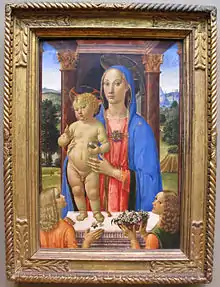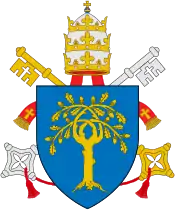Cosimo Rosselli
Cosimo Rosselli (1439–1507) was an Italian painter of the Quattrocento, active mainly in his birthplace of Florence, but also in Pisa earlier in his career in 1481-82 in the Sistine Chapel in Rome, where he painted some of the large frescoes on the side walls. Though generally regarded as a lesser talent in comparison to Sandro Botticelli, Pietro Perugino and Domenico Ghirlandaio, who were all also active at the Sistine Chapel, Rosselli was still able to win large and important commission throughout his career, a testament to his high level of activity in his native Florence. Important local commissions include a fresco in the cloister of Santissima Annunziata, Florence and those in the Chapel of the Holy Blood in Sant'Ambrogio, Florence.



Biography
Cosimo Rosselli was born in Florence. In 1460, at the age of fourteen, he became a pupil of Neri di Bicci, who also trained his cousin Bernardo di Stefano Rosselli.[1] An early work, completed in 1469, is the panel of Saints Barbara, Matthias and John the Baptist, painted for the chapel of the German confraternity in the church of the Santissima Annunziata, Florence. Rosselli also painted a fresco in the Annunziata's forecourt and a lunette of the Annunciation in the adjoining convent.
Rosselli was one of the painters called by Pope Sixtus IV to Rome in 1481 to fresco the sides walls of the Sistine Chapel, together with other masters including Sandro Botticelli, Pietro Perugino and Domenico Ghirlandaio. Rosselli and his collaborators, which is said to have included the young Piero di Cosimo, executed two or three frescoes: the Descent from Mount Sinai, the Last Supper and the Sermon of the Mount. The Passage of the Red Sea was once attributed to him or Ghirlandaio but is actually by Biagio d'Antonio, who also assisted Rosselli on the Last Supper. Giorgio Vasari wrote in his Lives of the Most Excellent Painters, Sculptors, and Architects that, as opposed to the other painters who followed a common pattern in the size and style of the frescoes, Rosselli used brighter colors and a large amount of gold, which granted him the appreciation of the Pope (who, hints Vasari, was not a deep expert of art).
Giorgio Vasari also mentioned other works by Rosselli, including the altarpiece of the Madonna and Child in Glory with Saints Augustine and Francis in the third chapel on the left of the nave of Sant'Ambrogio in Florence. In the same church is the Chapel of the Holy Blood with its frescoes by Rosselli, which Vasari praised highly, especially for a portrait of the young scholar Pico of Mirandola. The main scene in this chapel is a procession of the miracle-working chalice held in the very same church.
The Gemäldegalerie, Berlin has three pictures by Rosselli: a small Entombment of Christ and two altarpieces, one of the Madonna and Child with Angels, Saints and the Martyred Innocents and another of the Madonna of the Rosary.
Rosselli's chief pupil was Piero di Cosimo but also trained Fra Bartolomeo, Mariotto Albertinelli and Agnolo di Domenico del Mazziere.
According to Vasari, Rosselli died in 1484, but this is a mistake, as he was known to have been living on 25 November 1506.
References
- Piccoli Grand Musei, short biography.
- Sources
 This article incorporates text from a publication now in the public domain: Chisholm, Hugh, ed. (1911). "Rosselli, Cosimo". Encyclopædia Britannica. 23 (11th ed.). Cambridge University Press. pp. 745–746.
This article incorporates text from a publication now in the public domain: Chisholm, Hugh, ed. (1911). "Rosselli, Cosimo". Encyclopædia Britannica. 23 (11th ed.). Cambridge University Press. pp. 745–746.
Further reading
- Pope-Hennessy, John & Kanter, Laurence B. (1987). The Robert Lehman Collection I, Italian Paintings. New York, Princeton: The Metropolitan Museum of Art in association with Princeton University Press. ISBN 0870994794.CS1 maint: multiple names: authors list (link) (see index; plate 78)
External links
| Wikimedia Commons has media related to Cosimo Rosselli. |
